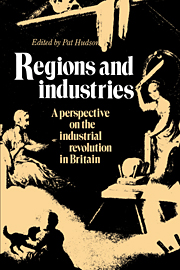Book contents
- Frontmatter
- Contents
- List of figures
- List of maps
- List of tables
- List of contributors
- Acknowledgements
- Introduction
- 1 The regional perspective
- PART ONE THE TEXTILE HEARTLANDS OF THE INDUSTRIAL REVOLUTION
- PART TWO OTHER PATHS, OTHER PATTERNS
- 4 Continuity and change in an industrialising society: the case of the West Midlands industries
- 5 Stages of industrialisation in Cumbria
- 6 The de-industrialisation process: a case study of the Weald, 1600–1850
- 7 Work, culture and resistance to machinery in the West of England woollen industry
- PART THREE THE DIVERSE NATURE OF THE OUTER REGIONS
- Index
7 - Work, culture and resistance to machinery in the West of England woollen industry
from PART TWO - OTHER PATHS, OTHER PATTERNS
Published online by Cambridge University Press: 05 May 2010
- Frontmatter
- Contents
- List of figures
- List of maps
- List of tables
- List of contributors
- Acknowledgements
- Introduction
- 1 The regional perspective
- PART ONE THE TEXTILE HEARTLANDS OF THE INDUSTRIAL REVOLUTION
- PART TWO OTHER PATHS, OTHER PATTERNS
- 4 Continuity and change in an industrialising society: the case of the West Midlands industries
- 5 Stages of industrialisation in Cumbria
- 6 The de-industrialisation process: a case study of the Weald, 1600–1850
- 7 Work, culture and resistance to machinery in the West of England woollen industry
- PART THREE THE DIVERSE NATURE OF THE OUTER REGIONS
- Index
Summary
The regional history of the British industrial revolution is one of marked contrasts of fortune; rapid growth and advance in one area, slow or sudden decline in another. Few industries, however, can match the remarkable contrast between the fortunes of the woollen cloth industry in the West of England counties of Gloucestershire, Somerset and Wiltshire and that of the West Riding of Yorkshire. As Wilson in a perceptive essay has shown, the West Riding woollen industry embarked on its road to supremacy early in the eighteenth century, but its progress was rapidly accelerated by the advent of early textile machinery. The West of England, on the other hand, though dominant at the start of that century, was by its close already in rapid relative decline. Not long after the Napoleonic Wars this became an absolute decline. The West of England's failure to adapt to changed circumstances, its slower take up of new technologies, reduced it from the forefront of the cloth trade to little more than a backwater by 1850. The work of Wilson and of Mann have done much to explain this eclipse, both stressing the importance of differences of product and especially in marketing practices as major reasons. While accepting that these were indeed important factors, this chapter is addressed to another aspect of this pattern, namely worker resistance to machinery. Such resistance was encountered in both regions but, with one major exception, resistance did not prove an obstacle to advance in the West Riding. This was not so in the West of England where major opposition greeted all new innovations.
- Type
- Chapter
- Information
- Regions and IndustriesA Perspective on the Industrial Revolution in Britain, pp. 175 - 198Publisher: Cambridge University PressPrint publication year: 1989
- 5
- Cited by

